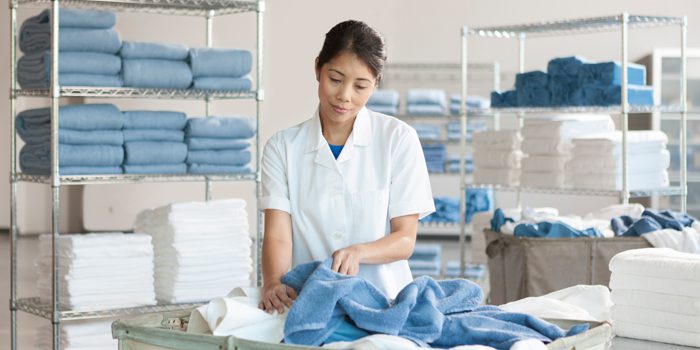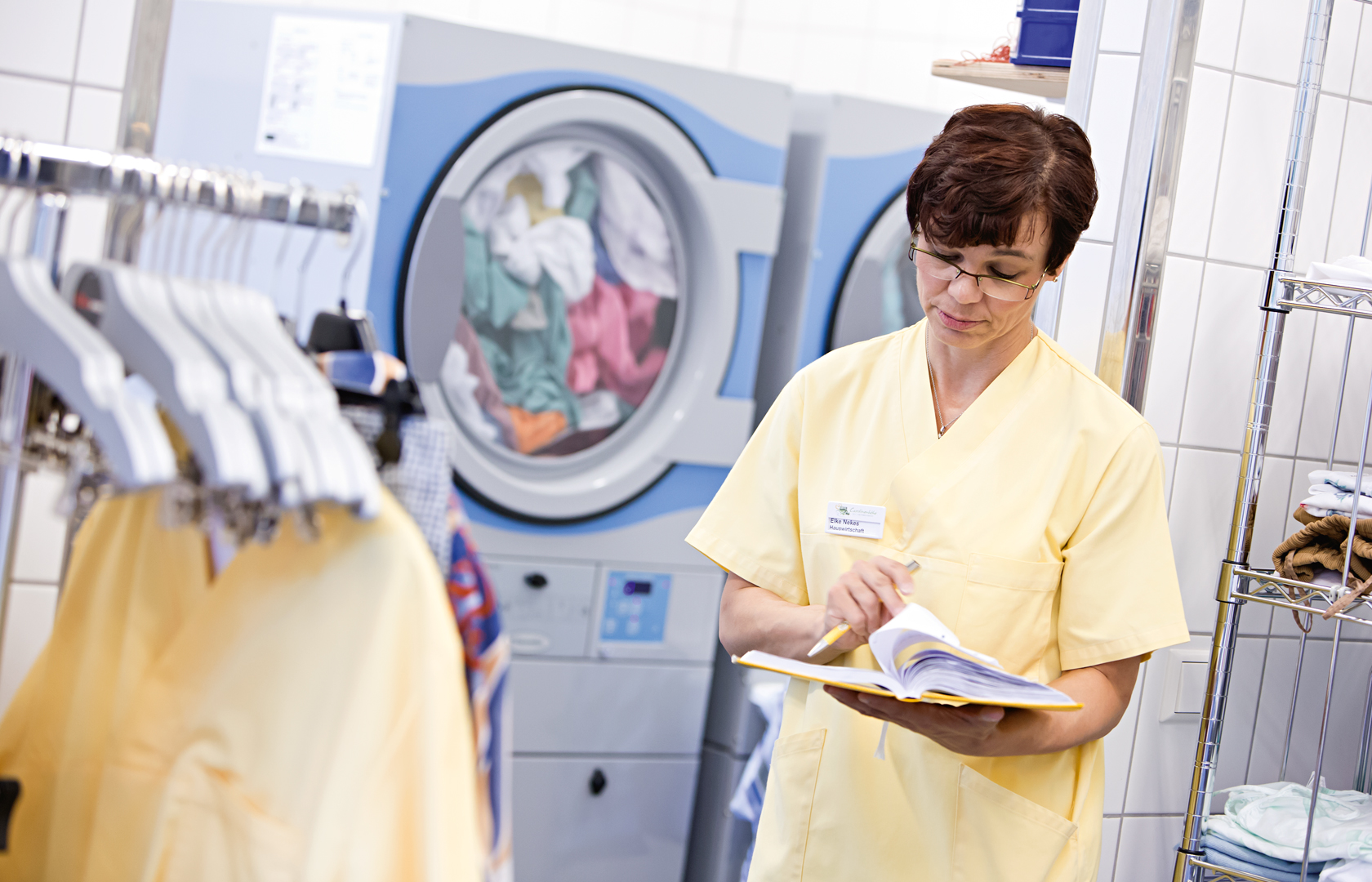As the world responds to COVID-19, Richard Jay – as an industry-leader in laundry infection-control – wants to ensure every business operating on-site laundry facilities is well-informed.
The Centers for Disease Control and Prevention (CDC) has estimated that the novel coronavirus can live anywhere from hours to days on surfaces made from a broad range of materials. This means that, across all the industries we serve – such as aged care, hospitality, government, healthcare, education, facility management and mining – it’s crucial that exemplary hygiene levels are maintained.
The healthcare industries in particular must be able to prove the quality of the processes they’re using and the laundry flow they’ve implemented, so they can minimise and prevent the risk of healthcare-acquired infections. Laundry is found throughout a hospital or care home – uniforms, bed linen, catering articles, surgical dress, cleaning items, patient clothing and so on – and it plays an essential role in patient safety whilst protecting employees in their place of work. Additionally, here at Richard Jay we’re currently seeing a surge in enquiries from food manufacturers and accommodation facilities wanting to know more about the Australian Laundry Standards and laundry hygiene. The importance of ensuring your on-site laundry adheres to the safe laundry practises is vital for all industries processing laundry – we can advise what’s necessary for your business, no matter where you are located in Australia.
Dirty laundry can spread germs to other areas, and therefore the clean linen needs to be handled as carefully as the dirty. This requires an in-depth understanding of laundry flows, the correct use of fabrics suitable to the task, and working practices that ensure the employees are aware of how their everyday actions can impact the laundry operation.
With this in mind, please take the time to read this ‘Mini Guide’ to hygienic laundry practices, based on the AS/NZS 4146:2000 Australian New Zealand Laundry Standards.
Dirty linen handling and sorting
The recommended method of soiled linen transfer between the patient or resident and the laundry is generally via a ‘collection trolley’, which provides the user with a one-to-four bag option. The most efficient method is to pre-sort linen directly into the collection trolley system as it’s being collected. With four-bag trolley, the recommendation would be to sort separately:
- Flatworks – bed sheets, pillowcases.
- Personals – patient or resident garments.
- Terry towelling – bath towels, terry mats, robes, face cloths etc.
- Infectious – garments that need isolating and laundering separately.
To facilitate sorting and loading, use coloured bags to differentiate between the various linen types. Ultimately, the purpose of sorting is to identify linen types for efficient production, to achieve the correct wash results specific to linen types and to establish the degree of soiling, for effective stain removal. Correctly sorted linen will have a positive flow on effect to all areas of the laundry.
- Collect textiles separately.
- Do not store dirty laundry for long periods.
- Do not bring dirty laundry into contact with clean laundry during handling and transport.

Washing guidelines
Soiled linen that is to be thermally disinfected shall be washed so that the temperature of the load is maintained at a minimum of 65°C for not less than 10 minutes, or at a minimum of 71°C for not less than 3 minutes.
Correctly sorted linen also speeds up the production process by offering a consistent load for finishing – pillowcases and sheets, for example, may be finished through a roller iron, whereas terry towelling products are finished in tumble dryers.
Richard Jay understands the importance of infection control and the potential for cross infection in laundries – that’s why the barrier laundry technology we offer is certified worldwide for the RABC method.
As a matter of good laundry practice, the laundry should have ongoing programs that record and monitor all key laundry processes, which should include clear procedures. The innovative Electrolux Efficient Dosing System (EDS) allows you to monitor all chemical costs, program and consumption data, as well as download reports that allows for the validation of every processed load. Electrolux’s Efficient Dosing System (EDS) will also give validation reports, including temperature reached and held, to adhere to the AS/NZS 4146:2000 Australian and New Zealand Laundry Guidelines. Efficient dosing is a smart system that can also save your organisation up to 40% in chemical costs.
- Ensure correct loading of washers for economy and optimal mechanical action.
- Ensure appropriate decontamination of washed linen is met.
- Ensure the wash program is suitable for the linen type.
- Ensure that protective garments, including gloves, are worn when handling soiled linen.

Transfer from washing to drying
Ideally the laundry design should incorporate a barrier configuration, whereby the soiled and clean side are completely separated – offering the ultimate prevention of cross contamination. Where practically possible, consideration should be given to the establishment of barrier laundries. With barrier technology, strict standards ensure that every wash program performs to the end of its cycle before unloading on the clean side. This is the best defence against the spread of micro-organisms and cross-infection.
Alternatively, in a standard laundry design, a 1-metre transit area between the soiled and clean sides of the laundry should be provided and marked clearly to aide in preventing any crossover.
- Do not store for long periods.
- Do not store washed linen in unsuitable places.
- Do not handle at the wrong time.
- Ensure that the laundry design is such that any possibility of cross contamination is minimised.
- Ensure that the correct equipment is provided to facilitate unloading/ transferring of linen between washing and drying.
Drying and finishing
Consistency is key in any laundry operation. The correct filling of a washer extractor will roll on to the drying process, providing consistent load sizes and linen types – resulting in uncomplicated dryer operation.
Prior to the commencement of ironing, we recommend the correct sorting of sheets, table linens and pillowcases to allow the operator to process by item type. This will simplify the feeding method.
Importantly, linen being processed through a heated roll ironer and ideally should not be starched – always ensure your main chemical provider is aware of your requirement to process through an ironer.
- Ensure correct temperature and contact times are adhered to during the finishing (ironing) process.
- Ensure the filling ratios in the drying process are not exceeded.
- Reduce the number of times the clean linen is handled from the time it is taken out of the washer until it leaves the laundry room (a maximum of four handlings.)

Laundry safety and maintenance
Before leaving the laundry, staff should ensure that:
- All equipment has stopped operation – it is not necessary to turn the power off.
- There is no tell-tale leaking from any water or chemical hoses and the floor is dry.
- Dryers have been unloaded, as linen sitting in a dryer all night can potentially ignite as a result of spontaneous combustion.
- Linen has been folded and stored, as linen sitting in a bucket-like laundry trolley, or alternatively heaped on a sorting/folding table, can also be at risk of spontaneous combustion.
- Finally, always ensure the machine’s undergone regular preventative maintenance, by an approved and certified service agent. Preventative maintenance on your machinery is vital to maximise performance, extend the life of your equipment, comply with Australian laundry standards and avoid potentially life-threatening incidents, and a Preventative Maintenance Agreement from Richard Jay is tailored to your business’s on-site laundry requirements.
As the experts in commercial laundry hygiene, infection control in laundries is always front of mind at Richard Jay – and never more so as the world continues to respond to the threat of COVID-19. If you’d like to talk to us about meeting your own infection-control laundry requirements, talk to us today – we’re ready to take your call.

